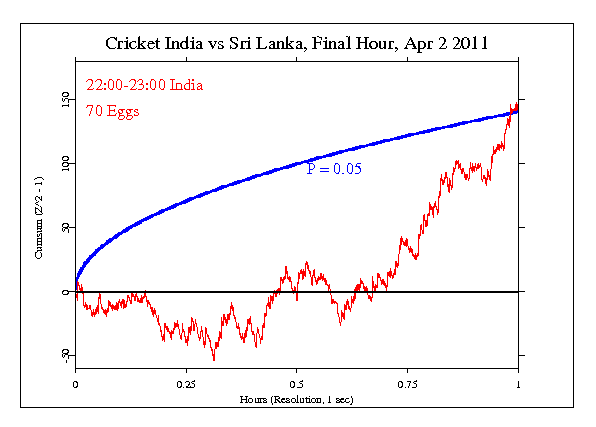|
My friend Chino sent a note saying that in the midst of the
tragedies on the world stage,
[T]here was some pleasant diversion in India.
Last night India played the final cricket match between
India and Sri Lanka at Bombay. It was truly an exciting
match and the whole subcontinent comprising 1.5 billion
people plus Australia, New Zealand, England and South Africa
(the main cricket playing Nations) were glued to their TVs
from 2.30 pm to 10.45 pm (India time), with the climax
coming at 10.50 pm when India won the world cup after a gap
of 28 years!
I was wondering whether it may be worth looking for some
effects during this time!
Though I didn't want to make this a formal event, it was
another opportunity to explore sporting events' possible
effects on the GCP network (they have generally been weak or
null), so I asked Chino for a more focused
prediction, and he responded that:
World cup fever gripped the country from the moment India
beat Pakistan on 30th March to enter the finals. The
India-Pakistan Match was in itself equally exciting with the
Prime Ministers of India and Pakistan watching it at
Chandigarh. That was on 30th March between 2.30 pm and
10.30 pm!
But may be you should look primarily between 10 pm and 11 pm
on 2nd April!
Indeed if we do look at this moment, the outcome is a significant deviation,
mostly coming just at the very end of this time period.
What is most striking, however, is the picture of the data
from the whole match. In contrast to the positive
deviation of the finish, the 8-hour period of the full match
shows a persistent low correlation in the network, so much
so that the trend culminates in a deviation that has roughly
100 to 1 odds. See the second figure below. Please remember
that these pictures of data are showing a combination of a
small signal in a sea of noise, meaning that they cannot be
interpreted literally.


It is important to keep in mind that we have only a tiny
statistical
effect, so that it is always hard to distinguish signal from
noise. This means that every "success" might be largely
driven by chance, and every "null" might include a real
signal overwhelmed by noise. In the long run, a real effect
can
be identified only by patiently accumulating replications of
similar analyses.
|